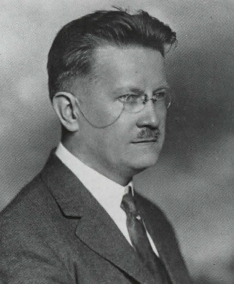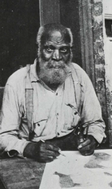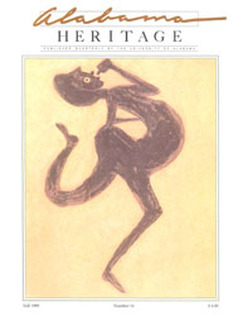|
On the cover: Female Drinker by Bill Traylor. (Courtesy Charles Shannon)
|
FEATURE ABSTRACTS
 Bohemian-born Joseph Cadek (1868-1927) established the Cadek conservatory of Music in Chattanooga, Tennessee, in 1904. His daughter, Lillian, pianist and violist, and his son Harold, a cellist, served on the faculty, while his eldest son, Ottokar, pursued a careeer with the New York String Quartet.
Bohemian-born Joseph Cadek (1868-1927) established the Cadek conservatory of Music in Chattanooga, Tennessee, in 1904. His daughter, Lillian, pianist and violist, and his son Harold, a cellist, served on the faculty, while his eldest son, Ottokar, pursued a careeer with the New York String Quartet.
Bohemia in America: Ottokar Čadek and the New York String Quartet
By Caroline Cepin Benser
Throughout the nineteenth century and well into the twentieth, Americans looked almost exclusively to Europe for musical inspiration and for musicians. American orchestras, quartets, and music schools invariably filled their ranks either with European performers or Americans who had been trained in the musical centers in Europe. Bohemia, with its capital Prague, was one of Europe's richest musical centers, and from this small, independent country came numerous musicians who were to leave their marks on American musical tastes and American music. Ottokar Čadek was the son of one musician who came to America to found the Čadek Conservatory of Music in Chattanooga. Čadek would follow in his father's footsteps. Among his many accomplishments would be the founding of the University of Alabama String Quartet and serving as concertmaster for the Birmingham Civic Symphony Orchestra. Thus, the musical heritage of Bohemia, with considerable help from the Čadeks, has filtered into every corner of America.
Additional Information
Alabama. Among the materials in this collection are numerous scrapbooks containing newspaper clippings that Čadek saved while on tour with the New York String Quartet, and clippings documenting his work in Birmingham and Tuscaloosa. Most notable among his personal letters are several from Percy Grainger, Ethel Leginska, and the composers Daniel Gregory Mason and Sidney Homer, and a postcard from Otakar Sevcik. Also included in the collection are numerous photographs and programs from throughout Čadek career.
About the Author
Caroline Benser is a graduate of the Music Department of the University of Alabama, where she became acquainted with the Cadek name. She received a Ph.D. in musicology from the University of Iowa and has taught at the University of Alabama and Stillman College. Benser' s Egan Wellesz (1885-1974): Chronicle of a Twentieth-Century Musician, was published by Peter Lang Publishers, New York, in 1985. Currently she is at work on a bio-bibliography of Randall Thompson for Greenwood Press.
For their assistance in the preparation of this article, the author wishes to thank Jerrie Čadek Lucktenberg and the staff of the William Stanley Hoole Special Collections Library, University of Alabama.
By Caroline Cepin Benser
Throughout the nineteenth century and well into the twentieth, Americans looked almost exclusively to Europe for musical inspiration and for musicians. American orchestras, quartets, and music schools invariably filled their ranks either with European performers or Americans who had been trained in the musical centers in Europe. Bohemia, with its capital Prague, was one of Europe's richest musical centers, and from this small, independent country came numerous musicians who were to leave their marks on American musical tastes and American music. Ottokar Čadek was the son of one musician who came to America to found the Čadek Conservatory of Music in Chattanooga. Čadek would follow in his father's footsteps. Among his many accomplishments would be the founding of the University of Alabama String Quartet and serving as concertmaster for the Birmingham Civic Symphony Orchestra. Thus, the musical heritage of Bohemia, with considerable help from the Čadeks, has filtered into every corner of America.
Additional Information
- Blum, David. The Art of Quartet Playing: The Guarneri Quartet in Conversation with David Blum (Alfred A. Knopf, 1986). [John Dalley, second violinist with the Guarneri, was a student of Čadek while he lived with the Čadek family and attended high school in Tuscaloosa for three years.]
- Runyan, Donald Clyde. "The Influence of Joseph O. Čadek and His Family on the Musical Life of Chattanooga, Tennessee (1893-1973)," (Dissertation: George Peabody College for Teachers, Vanderbilt University, 1980).
- Schwartz, Boris. Great Masters of the Violin: from Carelli and Vivaldi to Stern, Zuckerman, and Perlman (Simon and Schuster, 1983).
- Siskovsky, Jaroslav. Fiddler on the Hoof: The Odyssey; of a Concert Violinist (Dorrance and Co., 1975).
Alabama. Among the materials in this collection are numerous scrapbooks containing newspaper clippings that Čadek saved while on tour with the New York String Quartet, and clippings documenting his work in Birmingham and Tuscaloosa. Most notable among his personal letters are several from Percy Grainger, Ethel Leginska, and the composers Daniel Gregory Mason and Sidney Homer, and a postcard from Otakar Sevcik. Also included in the collection are numerous photographs and programs from throughout Čadek career.
About the Author
Caroline Benser is a graduate of the Music Department of the University of Alabama, where she became acquainted with the Cadek name. She received a Ph.D. in musicology from the University of Iowa and has taught at the University of Alabama and Stillman College. Benser' s Egan Wellesz (1885-1974): Chronicle of a Twentieth-Century Musician, was published by Peter Lang Publishers, New York, in 1985. Currently she is at work on a bio-bibliography of Randall Thompson for Greenwood Press.
For their assistance in the preparation of this article, the author wishes to thank Jerrie Čadek Lucktenberg and the staff of the William Stanley Hoole Special Collections Library, University of Alabama.
 Bill Traylor, 1854-1947. (Courtesy Charles Shannon)
Bill Traylor, 1854-1947. (Courtesy Charles Shannon)
Bill Traylor: Freed Slave and Folk Artist
By Maridith Walker
None of the experiences of a lifetime trained Bill Traylor for what he would accomplish at the end of his life. A tall, imposing black man, he had spent the majority of his adult years as a freed slave, living on the farm near Benton, Alabama, where he was born in 1854. Only in his old age did he leave the familiarity of that agrarian life for nearby Montgomery. And there, in 1939, he began to draw. Over the next three years, he honed his skills, developing a distinctive style and becoming an important representative of Folk Art.
Additional Information
About the Author
Maridith Walker first entered the pages of Alabama Heritage in the fall of 1988 with an article on possibly the best known and most flamboyant actress in Alabama history, Tallulah Bankhead. With this article, Walker turns her attention to another remarkable Alabama artist, this one shy, retiring, and--until recently--almost totally unknown. Some forty years after his death, the work of Bill Traylor, former slave, is now receiving national and international attention. Walker, a writer/editor for the University of Alabama News Bureau and the College of Arts and Sciences, is the editor of the Society for the Fine Arts Review. A descriptive essay by Walker appears in Alabama Memories (W. H. Smith, 1989), a collection of color photographs by Alabama Heritage chief photographer Chip Cooper.
The author and the editors wish to thank Charles and Gina Shannon for their kind assistance with this article.
By Maridith Walker
None of the experiences of a lifetime trained Bill Traylor for what he would accomplish at the end of his life. A tall, imposing black man, he had spent the majority of his adult years as a freed slave, living on the farm near Benton, Alabama, where he was born in 1854. Only in his old age did he leave the familiarity of that agrarian life for nearby Montgomery. And there, in 1939, he began to draw. Over the next three years, he honed his skills, developing a distinctive style and becoming an important representative of Folk Art.
Additional Information
- Cameron, Dan. "History and Bill Traylor," Arts Magazine 60 (October 1985): 45-47.
- Cardinal, Roger. Outsider Art (Praeger Publishers, 1972).
- Corker, Gylbert. "Bill Traylor at R. H. Oosterom Gallery," Art in America 68 (March 1980): 125.
- Larson, Kay. "Bill Traylor," The Village Voice (January 7, 1980).
- Livingston, Jane, and John Beardsley. Black Folk Art in America 1930-1980 (University Press of Mississippi, reprint ed. 1989).
- Rankin, Allen. "He Lost 10,000 Years," Colliers 117 (June 22, 1946): 67.
- Shannon, Charles. "The Folk Art of Bill Traylor," in Southern Works on Paper: 1900-1950 by Richard Cox, ed. (Southern Arts Federation, 1981).
- _____. "Bill Traylor's Triumph," Art & Antiques (February 1988): 61- 68+.
- Wallis, Brian. "Bill Traylor," Arts Magazine 54 (May 1980): 25.
- Bill Traylor, 1854-1947 (Hirschi & Adler Modern, December 2, 1985-January 11, 1986).
- Bill Traylor, 1854-1947 (Karsten Greve, April 18-May 24, 1986).
- Bill Traylor, 1854-1947 (Hirschi & Adler Modern, December 15, 1988-January 14, 1989).
- Bill Traylor Drawings, from the Collection of Joseph H. Wilkinson and an Anonymous Chicago Collector (The Chicago Public Library Cultural Center, February 6-April16, 1988).
About the Author
Maridith Walker first entered the pages of Alabama Heritage in the fall of 1988 with an article on possibly the best known and most flamboyant actress in Alabama history, Tallulah Bankhead. With this article, Walker turns her attention to another remarkable Alabama artist, this one shy, retiring, and--until recently--almost totally unknown. Some forty years after his death, the work of Bill Traylor, former slave, is now receiving national and international attention. Walker, a writer/editor for the University of Alabama News Bureau and the College of Arts and Sciences, is the editor of the Society for the Fine Arts Review. A descriptive essay by Walker appears in Alabama Memories (W. H. Smith, 1989), a collection of color photographs by Alabama Heritage chief photographer Chip Cooper.
The author and the editors wish to thank Charles and Gina Shannon for their kind assistance with this article.
Excerpts from the Encyclopedia of Southern Culture
Charles Reagan Wilson and William Ferris, coeditors
What defines the American South? Was the region shaped primarily by historical events or is its character a natural outgrowth of climate and geography? Is southern culture an accumulation of specific regional characteristics or is it something else? And what? The search for answers to questions such as these led two professors, Charles Reagan Wilson and William Ferris, into a ten-year collaborative project involving mroe than 800 scholars. The result of their efforts is the 1,600-page Encyclopedia of Southern Culture (University of North Carolina Press, 1989).
Alabama Heritage is proud to present a sampling of the entries found in the Encyclopedia, including discussions of Air-Conditioning, Alcohol, Maiden Aunts, and many other topics.
Additional Information
For more information on the Encyclopedia entries, see:
About the Editors
Charles Reagan Wilson and William Ferris have devoted much of the past decade to the Encyclopedia of Southern
Culture. Wilson, a Texan, is associate professor of history and southern studies at the University of Mississippi. He is the author of Baptized in Blood: The Religion of the Lost Cause, 1865-1920 (1980) and editor of Religion in the South: Essays (1985).
William Ferris, a native of Mississippi, is professor of anthropology and director of the Center for the Study of Southern Culture at the University of Mississippi. He has produced numerous films, record albums, and television documentaries in the field of folklore. His books include Blues from the Delta (1970); Images of the South: Visits with Eudora Welty
and Walker Evans (1977); and Local Color: A Sense of Place in Folk Art (1982).
To order a copy of the Encyclopedia of Southern Culture, contact The University of North Carolina Press, P.O. Box 2288, Chapel Hill, North Carolina 27515-2288. Telephone: (919) 966-3561.
Charles Reagan Wilson and William Ferris, coeditors
What defines the American South? Was the region shaped primarily by historical events or is its character a natural outgrowth of climate and geography? Is southern culture an accumulation of specific regional characteristics or is it something else? And what? The search for answers to questions such as these led two professors, Charles Reagan Wilson and William Ferris, into a ten-year collaborative project involving mroe than 800 scholars. The result of their efforts is the 1,600-page Encyclopedia of Southern Culture (University of North Carolina Press, 1989).
Alabama Heritage is proud to present a sampling of the entries found in the Encyclopedia, including discussions of Air-Conditioning, Alcohol, Maiden Aunts, and many other topics.
Additional Information
For more information on the Encyclopedia entries, see:
- Air-Conditioning: Raymond Arsenault, Journal of Southern History (November 1984); Raymond B. Becker, John Corrie, M.D.: Father of Air Conditioning and Mechanical Refrigeration (1972); Daniel Boorstin, The Americans: The Democratic Experience (1973); Robert Friedman, American Heritage (August-September 1984); Margaret Ingalls, Willis Haviland Carrier: Father of Air Conditioning (1952)
- Alcohol and Alcoholism: C. C. Pearson and J. Edwin Hendricks, Liquor and Anti-Liquor in Virginia, 1619-1919 (1967); W. J. Rorabaugh, The Alcoholic Republic: An American Tradition (1979); James B. Sellers, The Prohibition Movement in Alabama, 1702-1943 (1943); Muriel W. Sterne, in Alcoholism, ed. David J. Pittman (1967); Joe Gray Taylor, Eating, Drinking, and Visiting in the South (1982); Ian R. Tyrell, Journal of Southern History (November 1982); Daniel Jay Whitener, Prohibition in North Carolina, 1915-1945 (1945).
- Barbecue: John Egerton, Southern Food: At Home, on the Road, in History (1987); Gary D. Ford, Southern Living (May 1982); John Marshall, "Barbecue in Western Kentucky: An Ethnographic Study" (M.A. thesis, Western Kentucky University, 1981); Jerry Simpson, Southern World (May-June 1980); Stephen A. Smith, Studies in Popular Culture (No.I, 1985); Kathleen Zobel, Southern Exposure (1977).
- Burma Shave Signs: Frank Rowsome, Jr., The Verse by the Side of the Road (1965).
- Goo Goo Clusters: Margaret Loelo, Wall Street Journal (8 December 1982); John F. Persinos, Inc. (May 1984).
- Kudzu: William Shurtleff and Akiko Aoyagi, The Book of Kudzu: A Culinary and Healing Guide (1977); Larry Stevens, Smithsonian (December 1976);John J. Winberry and D. M. Jones, Southeastern Geographer (November 1973); Henry Woodhead, Atlanta Journal and Constitution (19 September 1976).
- Maiden Aunt: Josephine Carson, Silent Voices: The Southern Negro Woman Today (1969); Catherine Clinton, The Plantation Mistress: Woman's World in the Old South (1982); Maria Fletcher, "The Southern Heroine in the Fiction of Representative Southern Women Writers" (Ph.D. dissertation, Louisiana State University, 1963); Anne Goodwyn Jones, Tomorrow ls Another Day: The Woman Writer in the South, 1859-1936 (1981); John C. Ruoff, "Southern Womanhood, 1865-1920: An Intellectual and Cultural Study" (Ph.D. dissertation, University of Illinois, 1976); Lillian Smith, Killers of the Dream (1949); Julia Cherry Spruill, Women's Life and Work in the Southern Colonies (1938); Alice Walker, In Love and Trouble: Stories of Black Women (1973).
- Mules: William Ferris, North Carolina Folklore Journal (September 1973); Robert Byron Lamb, The Mule in Southern Agriculture (1963); Frederick Law Olmsted, A Journey in the Seaboard Slave States in the Years 1853-1854, with Remarks on Their Economy (1904); U. B. Phillips, Life and Labor in the Old South (1957); B. D. Raskopf and M. T. Danner, Public Horse and Mule Market at Nashville, Tennessee (1947); Theodore Rosengarten, All God's Dangers: The Life of Nate Shaw (1974); James Westfall Thompson, A History of Livestock Raising in the United States (1942).
- Opossum ("Possum"): Wayne King, New York Times (16 March 1975); Stanley Klein, Encyclopedia of North American Wildlife (1983).
- Wrestling: Elliott Corn, "The Manly Art: Bare-Knuckle Prize Fighting and the Rise of American Sports" (Ph.D. dissertation, Yale University, 1983); John Gutowski, Keystone Folklore (1972); Gerald W. Morton and George M. O'Brien, Wrestling to Rasslin ': Ancient Sport to American Ritual (1986); Newsweek (11 March 1985); Randall Williams, Southern Exposure (Fall 1979); Mark F. Workman, Folklore Forum (1977).
About the Editors
Charles Reagan Wilson and William Ferris have devoted much of the past decade to the Encyclopedia of Southern
Culture. Wilson, a Texan, is associate professor of history and southern studies at the University of Mississippi. He is the author of Baptized in Blood: The Religion of the Lost Cause, 1865-1920 (1980) and editor of Religion in the South: Essays (1985).
William Ferris, a native of Mississippi, is professor of anthropology and director of the Center for the Study of Southern Culture at the University of Mississippi. He has produced numerous films, record albums, and television documentaries in the field of folklore. His books include Blues from the Delta (1970); Images of the South: Visits with Eudora Welty
and Walker Evans (1977); and Local Color: A Sense of Place in Folk Art (1982).
To order a copy of the Encyclopedia of Southern Culture, contact The University of North Carolina Press, P.O. Box 2288, Chapel Hill, North Carolina 27515-2288. Telephone: (919) 966-3561.
